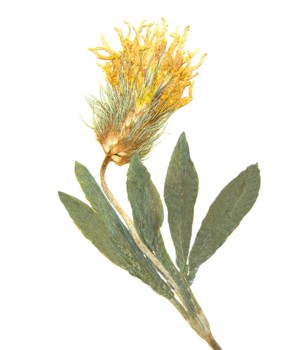Relatives
Trifolium apertum Bobr. - Open clover.
Taxonomic position.
Family Leguminosae Endl., genus Trifolium L., sect. Hiantia Bobr.Biology and morphology.
Annual herb. Stems erect, few to many, appressed, branching in the upper part, 20-60 cm high (in moist habitats to 1.0 m high). Leaves trifoliate, alternate except the uppermost, which are opposite; leaflets lanceolate, 1.5-4 cm long, 0.5-1.5 cm wide, thin with appressed hairs on both sides, finely toothed in the upper part, stipules elongated, almost linear. Heads are changing in shape from conical through ovate to cylindrical to the end of florescence, 2-3.5 cm long, 1.5 cm wide; florets pinkish-yellow, standard 14-15 mm long. Calyx 5-7 mm long, its tube outside with 10 distinct veins. Pod is obovate, one-seeded. Cross-pollinated. 2n=16.Distribution.
North-Western Caucasus, Turkey.Ecology.
Among bushes, along forage edges, meadows up to mid-mountain level.Utilization and economic value.
Valuable forage plant for southern regions. High nutritional value on account of a high leaf: stem ratio. Has higher digestibility than forage legumes such as lucerne, red clover, birdsfoot trefoil and crown vetch. Forage is protein-rich. Resistant to pests and diseases.Reference citations:
Brezhnev D.D., Korovina O.N. 1980. Wild relatives of the cultivated plants of flora of the USSR. Leningrad: Kolos. 376 pp. (In Russian)Galushko, A.I. 1980. Flora of Northern Caucasus: A field guide. Rostov-na-Donu. V. 2: 350. (In Russian)
Grossheim, A.A. 1952. Genus Trifolium. Flora of the Caucasus. Moscow-Leningrad: AN USSR. V. 5: 194-221. (In Russian)
Kolakovskiy, A.L. 1958. Flora of Abhasiya. Tbilisi. V. 3: 292 pp. (In Russian)
Phyodorov, A.A., ed. 1987. Flora of the European part of the USSR. V. 6: 254 pp. (In Russian)
Schischkin, V.K. & E.G. Bobrov, ed. 1945. Flora of the USSR. Moscow-Leningrad: AN USSR. V. 11: 129-176. (In Russian)


